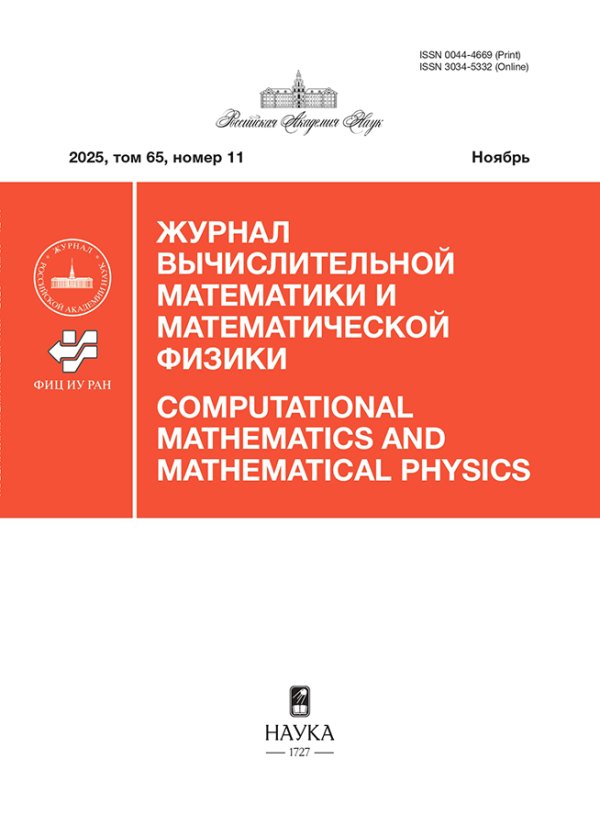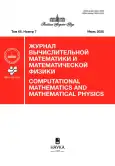АДАПТИВНЫЙ БЛОЧНЫЙ АЛГЕБРАИЧЕСКИЙ МНОГОСЕТОЧНЫЙ МЕТОД ДЛЯ МУЛЬТИФИЗИЧЕСКИХ ЗАДАЧ
- Авторы: Коньшин И.Н.1,2,3, Терехов К.М.1,4
-
Учреждения:
- ИВМ РАН
- ФИЦ НУ РАН
- Сеченовский университет
- Научно-технический университет «Сириус»
- Выпуск: Том 65, № 7 (2025)
- Страницы: 1118-1142
- Раздел: ОБЩИЕ ЧИСЛЕННЫЕ МЕТОДЫ
- URL: https://bakhtiniada.ru/0044-4669/article/view/304080
- DOI: https://doi.org/10.31857/S0044466925070055
- EDN: https://elibrary.ru/JXUXPE
- ID: 304080
Цитировать
Аннотация
Об авторах
И. Н. Коньшин
ИВМ РАН; ФИЦ НУ РАН; Сеченовский университет
Email: igor.konshin@gmail.com
Москва, Россия; Москва, Россия; Москва, Россия
К. М. Терехов
ИВМ РАН; Научно-технический университет «Сириус»
Email: terekhov@imn.ras.ru
Москва, Россия; Сочи, Россия
Список литературы
- Terekhov K.M. General finite-volume framework for saddle-point problems of various physics // Russ. J. Numer. Anal. Math. Model. 2021. V. 36. № 6. P. 359–379.
- Butakov I.D., Terekhov K.M. Two methods for the implicit integration of stiff reaction systems // Comput. Meth. Appl. Math. 2023. V. 23. № 1. P. 83–92.
- Terekhov K.M., Butakov I.D., Danilov A.A., Vassilevski Yu.V. Dynamic adaptive moving mesh finite-volume method for the blood flow and coagulation modeling // Int. J. Numer. Meth. Biomed. Eng. 2023. V. 39. № 11. e3731.
- Konshin I., Terekhov K. Block algebraic multigrid method for saddle-point problems of various physics // In: Russ. Supercomp. Days. V. 14388. Lect. Notes Comp. Sci. Springer. 2023. P. 17–34.
- Konshin I., Terekhov K. Distributed parallel bootstrap adaptive algebraic multigrid method // In: Russ. Supercomp. Days. V. 13708. Lect. Notes Comp. Sci. Springer. 2022. P. 92–111.
- Brezina M., Falgout R., MacLachlan S., Manteuffel T., McCormick S., Ruge J. Adaptive algebraic multigrid // SIAM J. Sci. Comput. 2006. V. 27. № 4. P. 1261–1286.
- Ladyzhenskaya O.A. The mathematical theory of viscous incompressible flow. V. 12. New York: Gordon & Breach, 1969.
- Rhie C.M., Chow W.L. Numerical study of the turbulent flow past an airfoil with trailing edge separation // AIAA J. 1983. V. 21. № 11. P. 1525–1532.
- Terekhov K.M., Tehelepi H.A. Cell-centered finite-volume method for elastic deformation of heterogeneous media with full-tensor properties // J. Comput. Appl. Math. 2020. V. 364. 112331.
- Terekhov K.M. Cell-centered finite-volume method for heterogeneous anisotropic poromechanics problem // J. Comput. Appl. Math. 2020. V. 365. 112357.
- Terekhov K.M., Vassilevski Yu.V. Finite volume method for coupled subsurface flow problems, II: Poroelasticity // J. Comput. Phys. 2022. V. 462. 111225.
- Terekhov K.M. Collocated finite-volume method for the incompressible Navier–Stokes problem // J. Numer. Math. 2021. V. 29. № 1. P. 63–79.
- Terekhov K.M. Fully-implicit collocated finite-volume method for the unsteady incompressible Navier–Stokes problem // In: Numerical Geometry, Grid Generation and Scientific Computing: Proc. 10th Int. Conf., NUMGRID 2020/Delaunay 130, Moscow, Russia, November 2020, Springer. 2021. P. 361–374.
- Terekhov K.M. Pressure boundary conditions in the collocated finite-volume method for the steady Navier–Stokes equations // Comput. Math. and Math. Phys. 2022. V. 62. № 8. P. 1345–1355.
- Terekhov K.M., Vassilevski Yu.V. Finite volume method for coupled subsurface flow problems, I: Darcy problem // J. Comput. Phys. 2019. V. 395. P. 298–306.
- George A., Ikramov Kh. On the condition of symmetric quasi-definite matrices // SIAM J. Matrix Anal. Appl. 2000. V. 21. № 3. P. 970–977.
- Li X.S. An overview of SuperLU: Algorithms, implementation, and user interface // ACM Trans. Math. Softw. 2005. V. 31. № 3. P. 302–325.
- Amestoy P.R., Duff I.S., L’Excellent J.-Y., Koster J. MUMPS: a general purpose distributed memory sparse solver // In: Int. Workshop on Appl. Parallel Comput. Springer, 2000. P. 121–130.
- Schenk O., Gärtner K. Solving unsymmetric sparse systems of linear equations with PARDISO // Future Gener. Comput. Syst. 2004. V. 20. № 3. P. 475–487.
- Terekhov K. Parallel multilevel linear solver within INMOST platform // In: Supercomputing, V. 1331. Commun. Comp. Inform. Sci. Springer, 2020. P. 297–309.
- Kaporin I.E. Multilevel ILU preconditionings for general unsymmetric matrices // In: Numerical Geometry, Grid Generation, and High Performance Computing. (Eds. V.A. Garanzha, Yu.G. Evtushenko, B.K. Soni, and N.P. Weatherill), Proc. of Int. Conf. NUMGRID/VORONOI-2008, Moscow, 10–13 June 2008, Folium, 2008. P. 150–157.
- Bollhöfer M., Saad Y. Multilevel preconditioners constructed from inverse-based ILUs // SIAM J. Sci. Comput. 2006. V. 27. № 5. P. 1627–1650.
- Saad Y., Suchomel B. ARMS: an algebraic recursive multilevel solver for general sparse linear systems // Numer. Lin. Alg. Appl. 2002. V. 9. № 5. P. 359–378.
- Kolotilina L.Yu., Yeremin A.Yu. Factorized sparse approximate inverse preconditionings, I: Theory // SIAM J. Matrix Anal. Appl. 1993. V. 14. № 1. P. 45–58.
- Kolotilina L.Yu., Yeremin A.Yu. Factorized sparse approximate inverse preconditioning, II: Solution of 3D FE systems on massively parallel computers // Int. J. High Speed Comp. 1995. V. 7. № 2. P. 191–215.
- Janna C., Ferronato M. Adaptive pattern research for block FSAI preconditioning // SIAM J. Sci. Comput. 2011. V. 33. № 6. P. 3357–3380.
- Ferronato M., Janna C., Pini G. A generalized block FSAI preconditioner for nonsymmetric linear systems // J. Comput. Appl. Math. 2014. V. 256. P. 230–241.
- Magri V.A.P., Franceschini A., Ferronato M., Janna C. Multilevel approaches for FSAI preconditioning // Numer. Lin. Alg. Appl. 2018. V. 25. № 5. e2183.
- Ruge J.W., Stüben K. Algebraic multigrid // In: Multigrid Methods SIAM, 1987. P. 73–130.
- Stüben K. A review of algebraic multigrid // in: Numerical Analysis: Historical Developments in the 20th Century, 2001. P. 331–359.
- Gries S., Metsch B., Terekhov K.M., Tonin P. System-AMG for fully coupled reservoir simulation with geomechanics // In: SPE Reservoir Simul. Conf. SPE, 2019. D021S011R003.
- Metsch B. Algebraic multigrid (AMG) for saddle point systems. PhD thesis. Bonn: Universitäts- und Landesbibliothek Bonn, 2013.
- Webster R. CLC in AMG solvers for saddle-point problems // Numer. Lin. Alg. Appl. 2018. V. 25. № 2. e2142.
- Webster R. Stabilisation of AMG solvers for saddle-point Stokes problems // Int. J. Numer. Meth. Fluids. 2016. V. 81. № 10. P. 640–653.
- Chang Q., Wong Y.S., Li Z. New interpolation formulas of using geometric assumptions in the algebraic multigrid method // Appl. Math. Comput. 1992. V. 50. № 2–3. P. 223–254.
- Chang Q., Wong Y.S. A new approach for the algebraic multigrid method // Int. J. Comput. Math. 1993. V. 49. № 3–4. P. 197–206.
- Bollhöfer M., Schenk O., Verbosio F. A high performance level-block approximate LU factorization preconditioner algorithm // Appl. Numer. Math. 2021. V. 162. P. 265–282.
- Saad Y. Finding exact and approximate block structures for ILU preconditioning // SIAM J. Sci. Comput. 2003. V. 24. № 4. P. 1107–1123.
- Vassilevski Yu., Terekhov K., Nikitin K., Kapyrin I. Parallel Finite Volume Computation on General Meshes. Springer, 2020.
- Bacunegekudi Ю.В., Коньшин И.Н., Копытов Г.В., Терехов К.М. INMOST – программная платформа и графическая среда для разработки параллельных численных моделей на сетках общего вида. М: Изд-во Московского унив., 2013.
- Ambartsumyan I., Khattatov E., Nguyen T., Yotov I. Flow and transport in fractured poroelastic media // GEM – Int. J. Geomath. 2019. V. 10. № 1. P. 1–34.
- Cesmelioglu A. Analysis of the coupled Navier–Stokes/Biot problem // J. Math. Anal. Appl. 2017. V. 456. № 2. P. 970–991.
- Ruiz-Baier R., Tajfetani M., Westermeyer H.D., Yotov I. The Biot–Stokes coupling using total pressure: Formulation, analysis and application to interfacial flow in the eye // Comput. Meth. Appl. Mech. Eng. 2022. V. 389. 114384.
- Li T., Caucao S., Yotov I. An augmented fully-mixed formulation for the quasistatic Navier–Stokes–Biot model // arXiv preprint arXiv:2209.02894. 2022.
- Huang J., Griffiths D.V. Return mapping algorithms and stress predictors for failure analysis in geomechanics // J. Eng. Mech. 2009. V. 135. № 4. P. 276–284.
- Huang J., Griffiths D.V. Observations on return mapping algorithms for piecewise linear yield criteria // Int. J. Geomech. 2008. V. 8. № 4. P. 253–265.
- Crook A.J.L., Willson S.M., Yu J.G., Owen D.R.J. Predictive modelling of structure evolution in sandbox experiments // J. Struct. Geol. 2006. V. 28. № 5. P. 729–744.
- Ferguson W., Richards G., Bere A., Mutlu U., Paw F. Modelling near-wellbore hydraulic fracture branching, complexity and tortuosity: A case study based on a fully coupled geomechanical modelling approach // In: SPE Hydraulic Fracturing Technology Conference and Exhibition, SPE, 2018. D021S004R003.
- Puri S., Hurtado J., Datye D., Dasari G., Searles K., Sanz P. Simulation of hydraulic fracturing of unconsolidated sands using fully coupled poro-elastoplastic models // Engineering, Environmental Science, Geology, 2015.
- Bigoni D., Piccolroaz A. Yield criteria for quasibrittle and frictional materials // Int. J. Solids Struct. 2004. V. 41. № 11–12. P. 2855–2878.
- Brooks R.H., Corey A.T. Properties of porous media affecting fluid flow // J. Irrig. Drainage Eng. 1966. V. 92. P. 61–88.
- Coussy O. Poromechanics. John Wiley & Sons, 2004.
- Gong P., Ni X., Chen Z., Wu Y., Wu J. Experimental investigation on sandstone permeability under plastic flow: permeability evolution law with stress increment // Geofluids. 2019. V. 1. 2374107.
- Zoback M.D. Reservoir Geomechanics. Cambridge Univ. Press, 2010.
- Klimczak C., Schultz R.A., Parashar R., Reeves D.M. Cubic law with aperture-length correlation: implications for network scale fluid flow // Hydrogen J. 2010. V. 18. № 4. P. 851.
- Wu X., Li B., Ren C., Gao Z., Xu J., Zhang Y., Yao C. An original coupled damage–permeability model based on the elastoplastic mechanics in coal // Rock Mech. Rock Eng. 2022. V. 55. № 4. P. 2353–2370.
- Guo J., Liu J., Li Q., Chen Z. Experimental study on the failure law of water-bearing coal and the evolution of permeability under plastic flow // Environm. Earth Sci. 2020. V. 9. P. 1–14.
- Karimi-Fard M., Durlofsky L.J., Aziz K. An efficient discrete-fracture model applicable for general-purpose reservoir simulators // SPE J. 2004. V. 9. № 2. P. 227–236.
- Settari A., Aziz K. Use of irregular grid in reservoir simulation // Soc. Petrol. Eng. J. 1972. V. 12. № 02. P. 103–114.
- Eymard R., Gallouët T., Guichard C., Herbin R., Masson R. TP or not TP, that is the question // Comput. Geosci. 2014. V. 18. P. 285–296.
- Lipnikov K., Shashkov M., Svyatskiy D. The mimetic finite difference discretization of diffusion problem on unstructured polyhedral meshes // J. Comput. Phys. 2006. V. 211. № 2. P. 473–491.
- Abushaikha A.S., Terekhov K.M. A fully implicit mimetic finite difference scheme for general purpose subsurface reservoir simulation with full tensor permeability // J. Comput. Phys. 2020. V. 406. 109194.
- Abushaikha A., Terekhov K. Adaptive dynamic grids and mimetic finite difference method for miscible displacement problem // Lobachevskii J. Math. 2024. V. 45. № 1. P. 143–154.
- Terekhov K. INMOST – A toolkit for distributed mathematical modeling. http://inmost.org, 2014.
- Voevodin V.I.V., Antonov A.S., Nikitenko D.A., Shvets P.A., Sobolev S.I., Sidorov I.Yu., Stefanov K.S., Voevodin Vad.V., Zhumatiy S.A. Supercomputer Lomonosov-2: large scale, deep monitoring and fine analytics for the user community // Supercomput. Front. Innov. 2019. V. 6. № 2. P. 4–11.
- Konshin I., Terekhov K. Sparse system solution methods for complex problems // Lect. Notes Comput. Sci. 2021. V. 12942. P. 53–73.
- Terekhov K. Supplementary material for MIPT course “Practical methods for system solutions”. https://github.com/kirill-terekhov/mipt-solvers/, 2021.
- Guennebaud G., Jacob B., et al. Eigen. http://eigen.tuxfamily.org.
Дополнительные файлы










